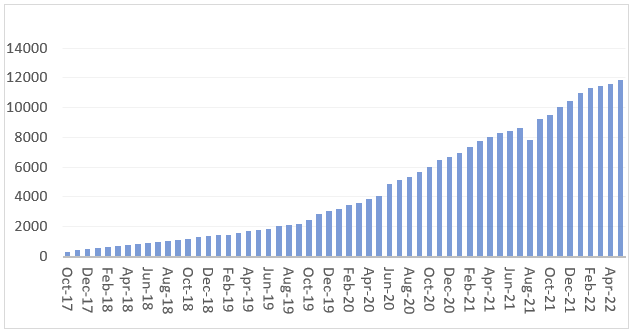Candriam Academy, launched in 2017, was the industry’s first free-to-access accredited training platform for sustainable and responsible investing. Click here to find out more about our Academy’s history.
The Institute’s flagship education project, Candriam Academy marked its fifth anniversary this year. The Academy has grown rapidly, helping over 12,000 users and adding new topics, languages, training modules and webinars. And now it has a new website, one which is energy efficient and simple to use. We built this as a demonstration of sustainability in action.
Our success: growing interest since 2017
 Source: Candriam, 2022
Source: Candriam, 2022
In this interview, Christel Lefevre, Head of Digital & Social Media Communication, talks about the Academy website project, and explains why simple is beautiful when creating a sustainable internet.
How different is this new website, and what did this project aim to achieve?
It is quite different because Candriam Academy today is very different from what it was when we launched it five years ago. At that time, when there were few courses on sustainable investing, our Academy was a very simple, basic offering. We had just one course consisting of four modules. It was available in two languages. Today there are four different courses, and with another on the way, in six European languages. We plan to expand into Arabic and Japanese. We also introduced news pages covering topical issues, and our ESG Talks, which are topical webinars. All this had brought layers of complexity for which the original website was not built.
So our first objective was to make our Academy web architecture simpler and more user-friendly, and to improve the digital experience of Candriam Academy users.
Our second big focus was on the sustainability of our website – we wanted to build an example of energy efficiency.
In other words, we had twin objectives: to ease and simplify the digital experience of Academy users, make it more enjoyable, while not overdoing the ”bells and whistles” to keep our portal’s carbon footprint low. In fact, the two are connected because websites with simpler structures require less energy on the part of users, who need to bowse less to find what they need.
Is sustainability a serious problem for the web?
Internet activity accounts for about 4% of the total greenhouse gas emissions worldwide[1]. But a lot of this energy is wasted on features and bandwidths that people do not actually need. It is paramount that the Internet industry eliminates the waste of energy.
To assess exactly how much energy is consumed by a particular website is no easy task, although approximate estimates can be obtained from www.websitecarbon.com and Safari Web inspector.
One of the best ways of improving the energy efficiency of a website is to streamline the user journey. We wanted a website that guides Candriam Academy users quickly and efficiently to their area of interest.
How did you achieve that efficiency?
Simple web architecture is, by definition, easier to navigate, and typically more effective in achieving its objectives. It is good for the planet too – the more data that needs to be downloaded to view a website, the more energy is consumed, and the worse the footprint.
Much of our focus has been on simplifying our website structure and determining its optimal size. Images and videos typically account for the majority of data in the page file so they are the most energy intensive elements of websites. We dealt with that problem by using only one image per page, and by limiting the size of each image.
We hope that this has made accessing information easier, and not only in terms of in how many clicks are needed. Simplicity does not demand the use of the latest expensive technology, a 5G mobile network or the most up-to-date web browser. That said, neither does it mean sacrificing more interesting formats such as animations.
New interactive elements will be gradually introduced across our content, and we hope that it will make learning about sustainability, an already fascinating topic, even more enjoyable.
[1] https://theshiftproject.org/en/article/unsustainable-use-online-video/
